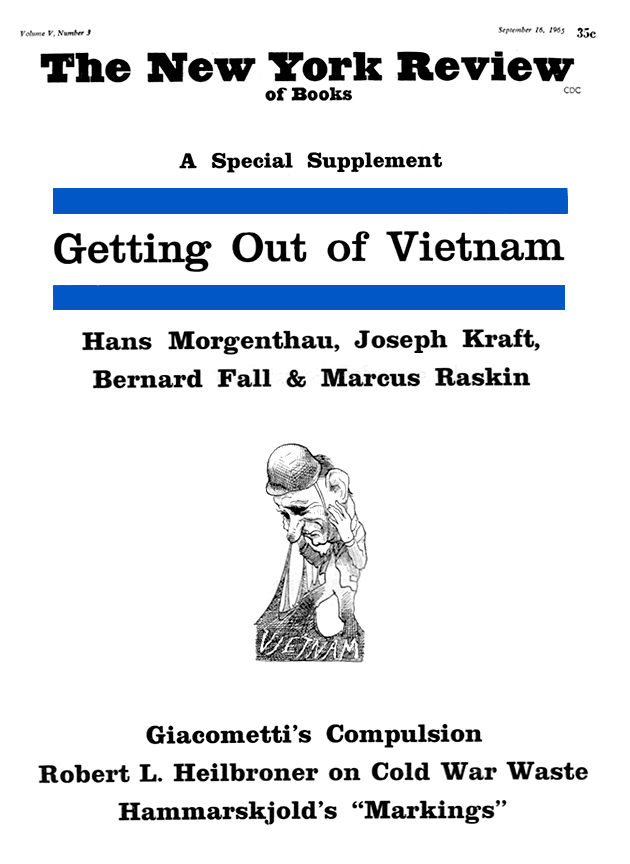In response to:
The Old Amalaki from the June 17, 1965 issue
To the Editors:
The review of Christopher Isherwood’s Ramakrishna and His Disciples by Frank Kermode (New York Review, June 17) raises a couple of problems—one for your Review and one for Mr. Kermode. In the first case, why commission a review of a book dealing with a subject or person from a writer who doesn’t like that subject or person? In recent issues, to take some blatant examples—a review of a book on Gide by someone who doesn’t like Gide; of Tiny Alice by someone who demolishes the play in order to attack homosexual writing in the theatre; of a book on Duchamp, Tinguely, Rauschenberg and Cage by someone who dislikes at least three of them; and—your most complete loading of the dice—of a biography of a Hindu teacher by a Western writer, by a reviewer who is a hostile outsider to Hinduism, above all when it “moves west.” In general terms, the effect is of a kind of literary picketing, as if editorial marching orders were issued to “Get Gide,” “Get Albee,” “Get Rauschenberg,” Get Isherwood,” to say nothing of slapping down homosexual playwrights, painters who fail to offend the public, and Hinduism, on the way. In specific terms, the reviewers decide in advance the position a work should take, then attack it for taking a different one.
Kermode on Ramakrishna is quite a classic example. Although Isherwood writes in his first chapter that (a) he is approaching Ramakrishna as a “phenomenon,” which he defines as “something extraordinary and mysterious” and “a fact, an object of experience,” and (b) that his work is to be taken as “no more than an introduction” to the standard biographies by “M.” and Swami Saradananda, Kermode immediately makes two complaints: (a) Isherwood doesn’t treat Ramakrishna as High Camp, and (b) he depends on the standard biographies instead of challenging them. The tone of the rest is similar, like the foreign tourist’s when he can’t understand why a native waiter doesn’t speak his lingo. Isherwood asks the reader to approach Ramakrishna “with the same open-minded curiosity you might feel about any highly unusual human being.” So Kermode, very open-mindedly stating that “one [i.e. Kermode] would have expected that Isherwood would try to give the reader some intuition of the sanctity of this god-man by camping him,” demands criticism and irony, and is aggrieved when he doesn’t get it, although he was clearly promised fact and exposition. Isherwood, again, proclaims himself a devotee and therefore not impartial. Finding only “scripture and hagiography,” Kermode sends this back too. Does he expect the Manager up there to explain that, blind or deaf, the customer is always right?
From here on, when he discusses “moving west,” I suppose it’s no surprise that Kermode feels the existence of Madame Blavatsky compromises the high claims made for this religion. (Has Norman Vincent Peale made him re-examine Christ?) The same logic makes him conclude that because Ramakrishna dressed up as a woman, he must have been a transvestite. (Virginia Woolf once dressed up as an Abyssinian prince, and we know she was.) And the real give-away, he thinks, is to be found in the story of Krishnamurti as told by Lady Lutyens. No matter that the claims for Krishnamurti were made entirely by Westerners, and denied by Hindus; no matter that the Vedanta group in Los Angeles is basically different from the Theosophical Society in that, like all Vedanta groups abroad, it was founded and is still run by a monk from the central monastery in India. It all goes to show, as he admits, that he’s not having any part of it; and to underline how knowledgeable and clearsighted he can be, Kermode concludes that even though Ramakrishna underwent the Tantric disciplines without “lapsing into depravity,” this was a very dangerous thing to do, as what happened to Mellors and Constance in Lady Chatterley’s Lover proves beyond a shadow of doubt…In this last, sublime non sequitur one seems to hear the booming voice of Lady Bracknell as she adds—“and that should be a warning to us all!”
Nevertheless, Kermode believes he’s “committed to reason” and that Hinduism is a “ship of fools.” In his looking-glass world, he certainly confirms Lichtenberg’s Law—that a book is like a mirror, and “if an ass peers into it, you can’t expect an apostle to look out.”
Gavin Lambert
Los Angeles
Frank Kermode replies:
This complaint strikes me as intemperate and foolish. Mr. Lambert knows very well that a journal entirely devoted to reviews will contain, if it is of any use, a high proportion of unfavorable reviews. He is wrong to suppose that I wanted to “get Isherwood” an author on whom my previously published comments, and my private opinion, are admiring. If Mr. Isherwood had really presented Ramakrishna as “an object of experience” instead of copying out the mythology we should have had a book of profound interest.
The point about mentioning Mme. Blavatsky is, of course, that an earlier generation of important writers was able to take her (and others such as Eliphas Levi and McGregor Mathers) very seriously, and in dismissing them as beneath notice Mr. Lambert is only making my point. Of course I am not “against” Hinduism, only interested in what becomes of it when it is adapted by Western participants in the flight from reason. It would never have occurred to me to comment on Ramakrishna’s success in avoiding a lapse into depravity under Tantric disciplines; this is what the devotees themselves say. From where Mr. Lambert stands it seems petty minded to dispute the Annunciation, the Virgin Birth, the Oven, the Rupee under the Mattress, and all that. From where I stand it is a complicated silliness to believe all this, and I tried to say so, without “getting” anybody.
This Issue
September 16, 1965


